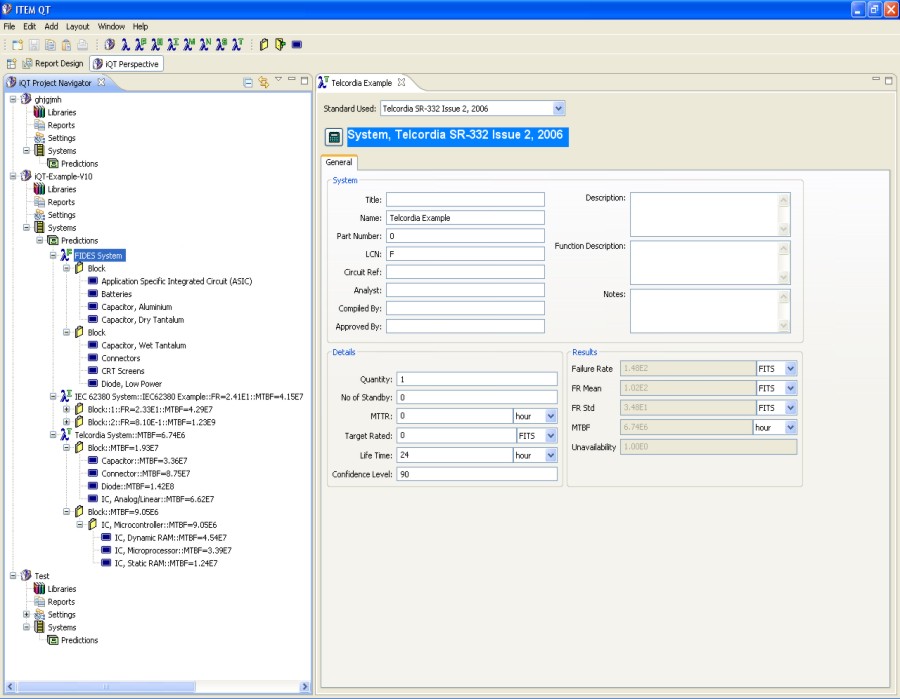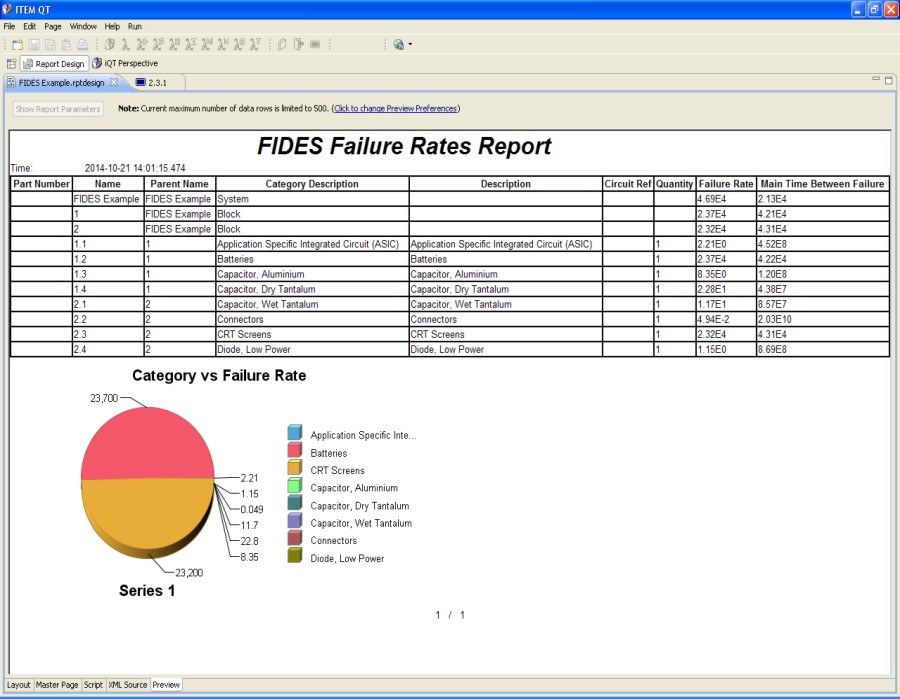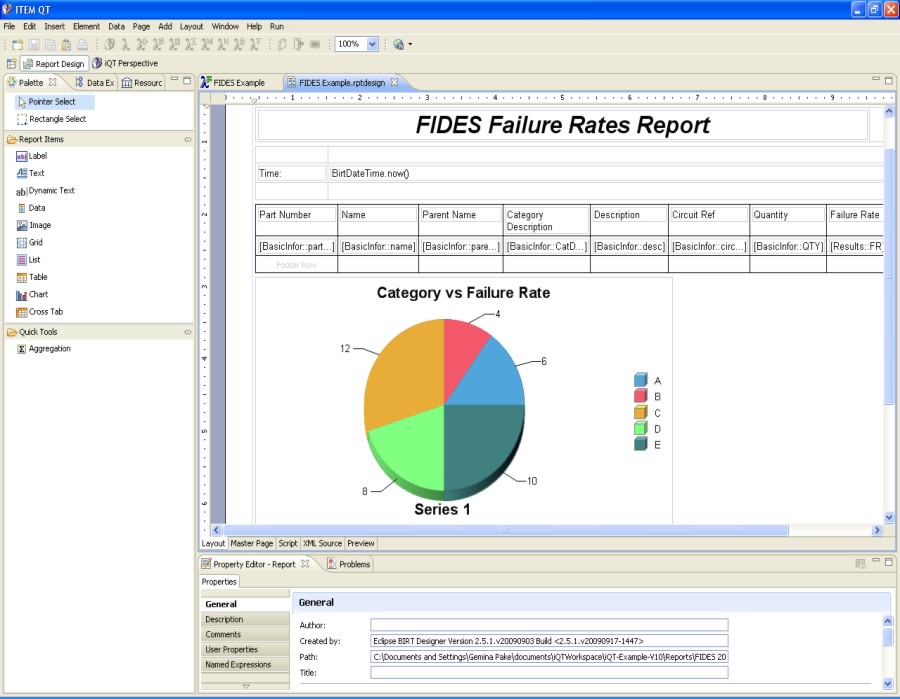
ITEM QT NSWC Module
NSWC Mechanical Reliability Prediction Software
The NSWC module of IQT uses a series of models for various categories of mechanical components to predict failure rates based on temperature, stresses, flow rates and various other parameters. It provides models for various types of mechanical devices including actuators, springs, bearings, seals, electric motors, compressors, pumps, brakes and clutches and many more. NSWC is currently the only one of its kind.
Due to the wide range of failure rates that occur in apparently similar components, the NSWC Mechanical Prediction module does not rely on failure rate data alone. It also accounts for material properties, operating environment, and critical failure modes at the component level.
The NSWC 06/LE1 Standard is a commonly used model for mechanical components. Standard procedures for predicting the reliability of mechanical components, sub-systems and systems are defined in the Naval Surface Warfare Center Handbook of Reliability Prediction Procedures for Mechanical Equipment.
The NSWC Handbook:
The “Handbook of Reliability Prediction Procedures for Mechanical Equipment” contains twenty-three chapters of information with equations, engineering tables and procedures for estimating the reliability of a mechanical design for the intended operating environment. Handbook procedures are used to determine the reliability of fundamental components such as springs, bearings, seals and gaskets. These component applications are then expanded to sub-assemblies such as valves, actuators and pumps and then to the system level. Equations in the Handbook include parameters for material properties, operating conditions and stress levels at each equipment indenture level providing a full reliability, maintainability and availability analysis at the system, assembly and component indenture levels.

Components
The handbook covers the following types of mechanical components:
- Seals and Gaskets
- Springs
- Solenoids
- Valve Assemblies
- Bearings
- Gears and Splines
- Actuators
- Pumps
- Filters
- Brakes and Clutches
- Compressors
- Electric Motors
- Accumulators
- Threaded Fasteners
- Mechanical Couplings
- Slider-Crank Mechanisms
- Sensors and Transducers
- Shafts
- Belt Drives
- Fluid Conductors
- Miscellaneous Parts

Open and Extensible
Focused on reliability, safety, and risk assessment, our iQT product is a highly extensible framework that provides common infrastructure for any kind of system modeling.
The capable nature of iQT is achieved by an existing Java platform foundation that is widely supported in your business environment. By following the predefined interface, your team has the ability to create plug-ins that extend the capabilities of iQT . The following are examples of possible iQT extensions:
- New editors or viewers for a given model (file) type
- New quantification model types
- New result types
- New analysis engines
The well-established core services of this platform provide the essential functionality to model and analyze reliability, risk and safety projects. Regardless of the configuration of a particular installation, the core services are available in the framework.
All extensions are highly modular. By allowing capabilities to be added to or removed from the software without affecting other extensions, new functionality, perhaps a new prediction standard, can be added without requiring reconfiguration or redesign of the source code.
iQT is a fully functional open environment, supporting the addition of third-party plug-ins such as:
- Project management plug-ins
- Version management plug-ins
- Third-party computational environment tools (e.g. MATLAB)
- Third-party modeling tools (e.g. data analysis)
- Documentation tools (e.g. PDF viewers)
- Search tools

Features
- Built on proven and recognized analysis engines
- Customizable, cross-platform, multi-user, open-framework
- Supports the same modules as our flagship product ITEM ToolKit
- Update manager allows the user to upgrade to the latest version online
- Refrains from loading and creating models until needed, dramatically reducing memory usage and startup times
- Easily create or modify existing prediction approach with a prediction module editor
- True cross-platform capabilities through Java-based framework and analysis engines
- Library function allows automated update of models
- Easily revert to any previous version of a model
- Restrict access to particular models to one user or group
- Create different branches and variations of the same model for ‘what if’ investigations
- Merge project work from multiple teams into a single project
- Designed by engineers for engineers
- Fully functional open environment supporting addition of third party plug-ins
- Stores external documentation like MS Word, PDF or CAD drawing files
- Configurable to interface with other programs
- Powerful, proven and configurable quantification engines
- Open standard allows users to make changes to the model outside of iQT
Contact us now for a free quotation or an online demonstration.

Key Features:
- Mechanical Reliability Prediction Software
- Based on the NSWC 06/LE1 Standard
- Customizable, Multi-User, Open-Framework
- True Cross-Platform Capabilities
- Modular Design Allows Choice of Analyses
- Supports Third-Party Plug-Ins
- Extensive Reporting and Charting Facilities
- Stores External Documentation
- Configurable Quantification Engines

Available Modules:


